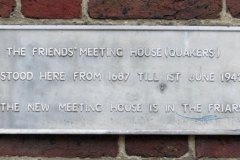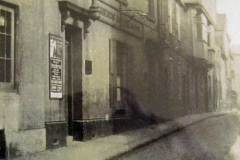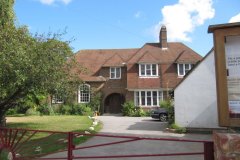Canterbury Lane (Original) & The Friars (modern)
Down Canterbury Lane (running by the side of Superdrug) we find a memorial plaque (Image 1) which reminds us of the Quaker Friends’ Meeting House which stood here for over 250 years. Opened in 1687, with permanent seating installed in 1772, the building was destroyed in the WW2 bombing raid on Canterbury carried out on 1 June 1942. The structure (Image 2) was large, brick built with a cemented front, and seating for 100 worshippers. The Quaker burials took place some distance away – in a walled plot at the corner of St Dunstan’s and Forty Acre Road, adjacent to the Jewish cemetery. Registers of births, marriages, deaths and burials for the Canterbury Lane Meeting House survive from the mid-17th century to the 1770s, held at the National Archives. A replacement Meeting House was built in The Friars, near the Marlowe Theatre, in 1956 (Image 3).
Little is known of the detailed activities of early Canterbury Quakers. A few snippets follow:
- The Quaker missionary William Caton is known to have visited Canterbury in 1655 – his memoirs show that he got on well with the Baptists and Independents who were already established in the city.
- The son of the writer Richard Barham records, in his biography of his father, a childhood prank carried out by his father around 1800. With a school friend Richard entered a prayer meeting at the Friends’ Meeting House, held up a penny tart, and awarded it to whoever spoke first. The two boys were given short shrift by those present.
- Celebrations to mark the royal wedding of 1863 (between Edward Prince of Wales and Princess Alexandra of Denmark) included a meal offered at the Friends’ Meeting House for parents of pupils at the Ragged (charity) School.
- The Meeting House provided a venue in 1870 for a public meeting (no women and no youths allowed) to protest at the working of the Contagious Diseases Act, introduced to combat the high rates of venereal disease in garrison towns. The compulsory medical inspection for prostitutes led to unseemly street scenes, and the legislation was repealed in 1883. Canterbury folk had come to appreciate apparent lower levels of prostitution, so they then convened public meetings to protest at the repeal!
Sources: Barham (1880); Bateman (1991); Evans (1845); Hasted (1800); Kelly’s directory 1899
DL



